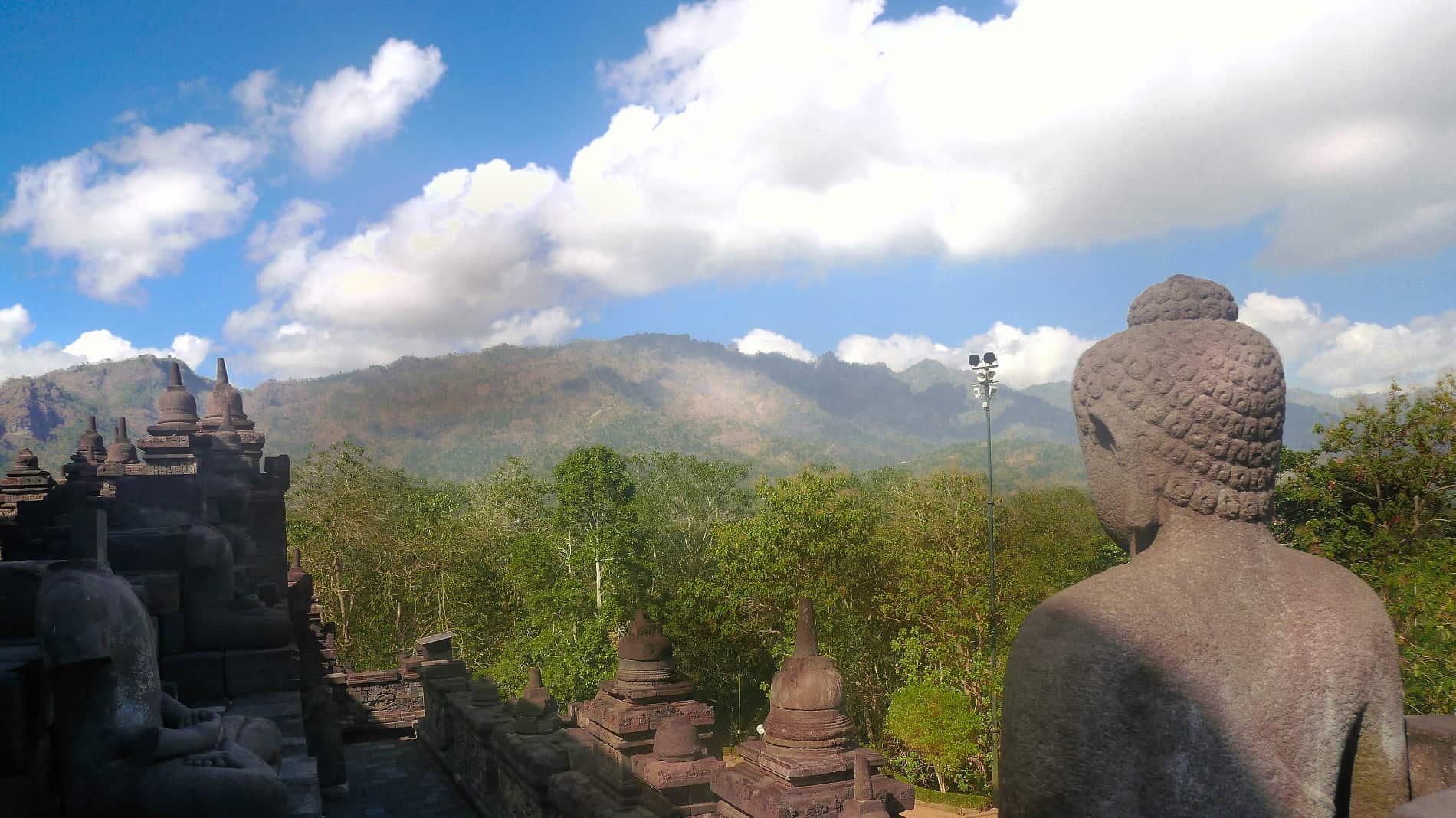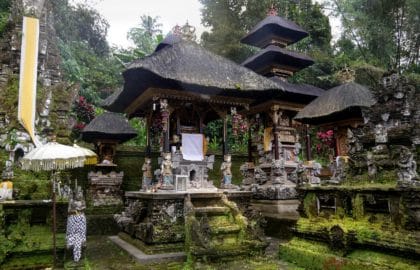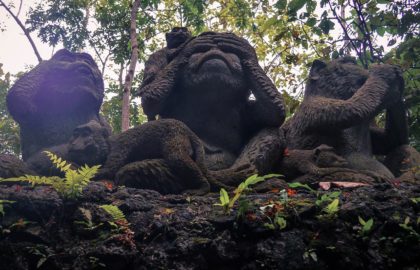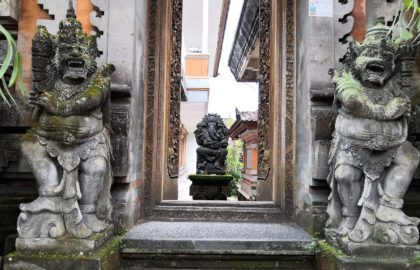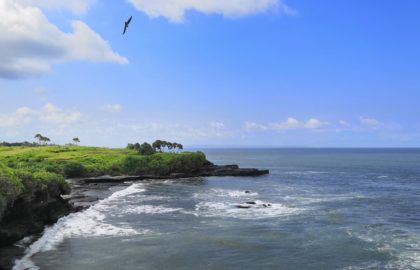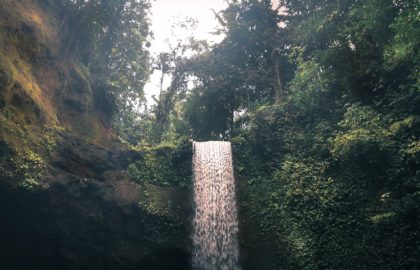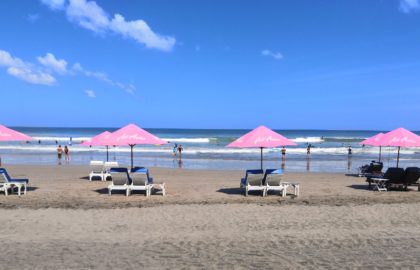📍 Yogyakarta, 17th of August 2018.
Sunrise over the Borobudur temple
Waking up at 3 AM is hardly fun for anyone, especially when you get to sleep in a fantastic bed. The desire to explore and launch into an adventure, however, did some magic (at least to one of us ;)), so with the first sounds of the alarm clock we got up, quickly got ready and were on our way to Borobudur – THE temple to visit in Indonesia. Traffic at this time of the day is really limited, so we could really enjoy accelerating a bit more than would have been possible during the day (but unlike most locals still respected the red light – it takes more than a week to fully integrate ;)).
To avoid the pricey ticket to watch sunrise at the Borobudur temple, we opted for going to Punthuk Setumbu - a hill next to it. It is way more affordable and apparently anyway better since it is located higher than the temple and therefore offers a much better view. The place is cute and well-maintained, the stairs to the viewing point lit by oil lamps – felt like joining some secret society of sunrise worshippers or something (wish there was such a thing).
Seeing the absolute darkness slowly giving place to light; the silhouette of volcanoes and the curves of the valley gradually being revealed; the sky changing its colours across the entire palette and the whole performance culminating with the bright golden sun raising and announcing that a new day has begun was an awesome (in the original meaning of the word) yet very serene experience. It gave us a lot of positive energy and boost for the rest of day! (an experience to repeat, hopefully next time there will be less clouds so that David’s expectations of the ultimate sunrise with a golden disk going up in a perfectly clear sky can be satisfied! )
By the way, we were so proud of us for thinking of taking some breakfast to the sunrise hill! We were finally not hungry starting a new day.
The Borobudur temple
At around 6:30 AM we got to the temple. What’s interesting about Borobudur, among many other things, is that although it is the world’s largest Buddhist temple, after Java’s conversion to Islam in the 14th century, Buddhists moved eastward, abandoning the temple to be lost under volcanic ash and forest for centuries until an English archaeologist rediscovered it in the 1800s! Little to no references to Borobudur can be found in any historical documents of the time, leaving the temple full of unresolved secrets and mysteries. I am always wondering how do places get lost and forgotten, I wonder if centuries from now the same will happen to the places we know and frequent?
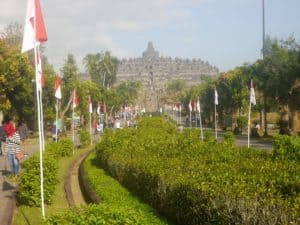
From Sanskrit, “Borobudur” means “monastery on the hill”, and as you can see on the picture the name is really fitting (“Borobudur” just sounds so much cooler :D). When looking from above, the building is shaped of mandala – symbolising Buddhist cosmology and the nature of mind (!). There are three horizontal separations symbolising the three levels of enlightenment according to Buddhism – the physical world (or the world of desires), the transition (the world of shapes) and the enlightenment (the formless world or the emptiness). As we later learned, this concept of “emptiness” is very prominent in Buddhism and is definitely worth reading more about! (I have started my exploration with R. Wright’s “Why Buddhism is True”).
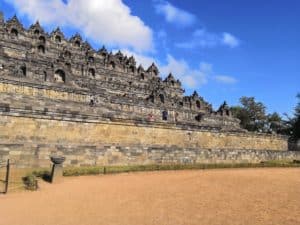
When visiting the temple, one is supposed to go in the clock-wise direction, level by level (total of nine) reading the stories carved on over a thousand of reliefs. You could spend hours philosophising about the topics raised on those reliefs, one of the most prominent ones being of cause and effect (karma) – such vivid, relevant and relatable examples - what a great storytelling! We were absolutely blown away!
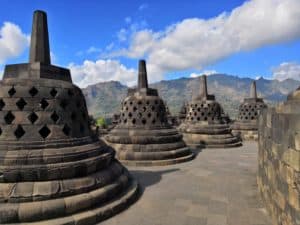
The top level hosts 72 stupas (bell-shaped pyramids) containing statues of Buddha in various positions (although a lot of Buddha heads have been stolen/destroyed). Stupas are protected by the statues of lions, which look friendly rather than intimidating as they are smiling. This level of the temple is the most crowded with tourists. We got really annoyed with how disrespectful many of those behaved and finally understood why there was the need of putting “don’t touch” and “don’t climb” signs everywhere.
Tourists aside, we could go for hours excitedly talking about how many fascinating things we learned from our guide about this temple, about the principles of Buddhism, the endless number of messages hidden in architectural and structural forms of the building – all so smart, so wise and yet so simple. This was an eye-opening visit, David and I both decided to spend more time reading about Buddhism in the nearest future.
A quick lunch stopover

We got a combo-ticket for both UNESCO heritage sites - Borobudur and Prambanan (40 dollars, not cheap but didn’t regret it for a second). The second temple was only 30 km away, but with the traffic it took us over 1.5h with the scooter. On the way to the Hindu temple we stopped on one of the side streets and got a delicious lunch in a tiny shop. Don’t think they get a lot of tourists there - the couple presumably owning the shop was rather amused with us trying to order We ate a delicious cap cay seafood (wok veggies) and mie ayam (noodles with chicken) – somehow the less touristy the place, the yummier the food. The jasmine ice tea was way too sweet, but this was our own mistake – should have known by now to always order without “gula” (sugar), as indonesians add it to virtually every drink. It’s even too sweet for David, which says it all 😉
The Prambanan temple
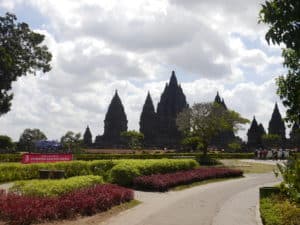
Prambanan was built slightly later than Borobudur, as a statement of Hinduism returning to Java. The temple was completely destroyed during multiple earthquakes and is ongoing a continuous and lengthy renovation process. At its prime, it had over 200 temples, whereas now there are only about 20 reconstructed. Our guide said the temple should be fully reconstructed within our lifetimes, that is, if you believe in reincarnation Still, I wonder how the place would change within the next 20-30 years. With tourism to the destination on the rise, there is hope some of the increased revenue would go into this project.
Prambanan, although very close to Borobudur, looks completely different. Instead of one main structure, there are multiple temples dedicated to various deities scattered around. Each temple has a staircase leading up, inside of it – a statue. Of the three main temple is that of Shiva – to whom the entire complex is dedicated. Shiva stands for Transformation – destroys the bad and reconstructs the good, for that he has 4 hands. His wife, however, has 8. She is a real power lady and stands for energy and creative power. The statue shows here controlling her inner demons Our guide said his wife had 12 hands, especially when they go shopping – funny guy 🙂
So interesting that so close to each other, the temples show teachings of different religions. There was a lot to learn about Hinduism in Prambanan, but our brains were already full with ideas and concepts we were exposed to in Borobudur. A lot to think about and digest.
Once done with the tour, we took a stroll to the three outlaying temples. It seems not many tourists are aware of those or bother going there, so we were almost alone – what a treat!
Originally we were considering to visit some waterfalls or go to the beach after the temples, but the reality was that we were absolutely knackered. Early dinner and bed it is! Tomorrow – Surabaya!
Driving around Yogya
(i) We did some fact checking, but the majority of information in this post are based on what the guides told us, so subject to language barriers and understanding 😉 Regardless, unless you are an expert on the topic, we would STRONLGY recommend getting a guide at both temples. It completely changes your visiting experience!
